The Archipelago of Cabrera comprises 21 islands, islets and small stacks lying 10 nautical miles (19 km) off the southern tip of Mallorca, Balearic Islands, Spain in the western Mediterranean. The largest island is Cabrera (Goatherd Island) at 1154 ha. Vegetated islands and islets include Illa des Conills (Rabbit Island; the second-largest at 137 ha), Na Redona, Illa des Fonoll, Na Plana, Na Pobra, L’Imperial, Na Foradada, L’Estell de Fora, L’Estell d’en Terra, Es Carabassot de s'Estell d'en Terra, L’Illa de ses Bledes, L’Esponja, L’illot de na Foradada, L’Estell de s’Esclata-sang, L’illa de ses Rates ((Rat Island), L’Estell des Coll, L’illa de l’Olló and L’illot Pla (the smallest at 0.1 ha).
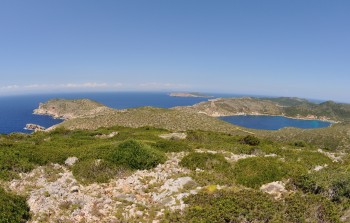
View from the highest point on Cabrera. In the distance is Illa des Conills, a main breeding site for the Balearic Shearwater in the archipelago. The vegetation of all the islands is mostly a low Mediterranean scrub adapted to the coastal environment
The islands fall within the Cabrera Archipelago Maritime-Terrestrial National Park, declared in 1991 with a total terrestrial area of 1318 ha and a marine area of 8700 ha. The Archipelago is a Special Protection Area (SPA) in terms of the European Birds Directive for its seabirds and coastal raptors, and it is also included in the Specially Protected Areas of Mediterranean Importance (SPAMI) network in terms of the 1995 Protocol Concerning Mediterranean Specially Protected Areas and Biological Diversity in the Mediterranean. It is also a BirdLife Important Bird Area. The islands are uninhabited save for National Park staff personnel, Guardia Civil police and day tourists. Overnight stays are allowed for up to 50 yachts using fixed mooring bouys within the park’s waters (click here for more information on the park).
The population of the ACAP-listed Balearic Shearwater Puffinus mauretanicus on Cabrera is estimated as 75 pairs in caves and crevices in the sea cliffs of Picamosques and Cap Vermell. The species also breeds on Conills (350 pairs) and on the four small islands of L’Imperial (35), Na Pobra (eight), Na Plana (one or two) and Na Redona (30). Breeding no longer occurs on Fonoll and Rates (although non-breeding birds are now visiting the latter island, where two pairs had bred in the 1990s).
In addition, 2008 censuses revealed 845 pairs of Scopoli’s Shearwaters Calonectris diomedea breeding on 12 of the archipelago’s islands along with 600 pairs of Mediterranean Storm Petrels Hydrobates pelagicus melitensis, including on tiny L’illot Pla.
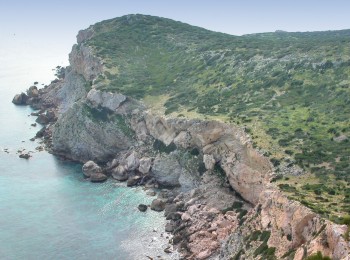
The boulders at the bottom of the cliffs of Blanquer on Conills, breeding site for 300 pairs of Balearic Shearwaters. Rats and rabbits have been eradicated and Balearic and Scopoli’s Shearwaters have now commenced breeding elsewhere on the island
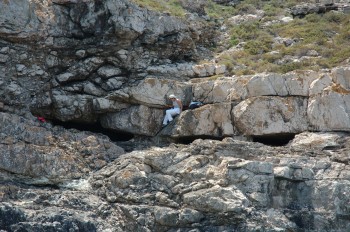
Munn’s Cave on Na Pobra (north island group), one of the few localities in the Balearic Islands where Balearic and Scopoli’s Shearwaters and Mediterranean Storm Petrels breed together
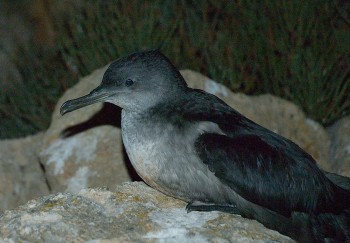
One of the first fledged Balearic Shearwaters observed in the area of Corrals on Conills
Balearic Shearwaters were once widespread on the main island of Cabrera. However, human exploitation and the introduction of predators (Black or Ship Rat Rattus rattus, Small-spotted or Common Genet Genetta genetta, feral Domestic Cat Felis catus and European Weasel Mustela nivalis; all now present only on Cabrera) caused a great impact on the distribution of the archipelago’s seabirds, with rats causing local extinctions of shearwaters and the storm petrel on some of the small islands. Rodent eradication has now been achieved on all the small islands, including Conills, leading to shearwaters breeding in new areas. Although reinvasions are common on those islands within 100 m of Cabrera they are quickly detected and resolved. National Park regulations establish as a priority the eradication of all introduced mammals on Cabrera.
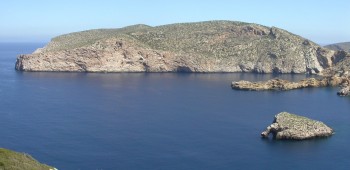
The sea cliffs of Cap Vermel and Picamosques on Cabrera and L’illa de ses Rates. Rodents on Rates have been eradicated, but the distance to Cabrera is only 80 m, so reinvasions are frequent
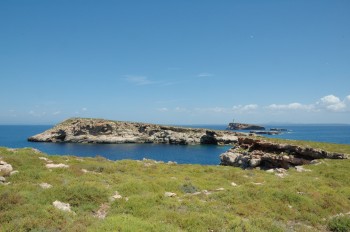
The northern island group of Na Foradada, Na Pobra and Na Plana have always been rodent-free
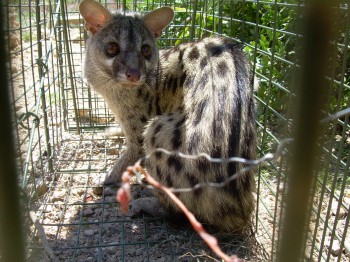
Small-spotted Genets were introduced to Mallorca about a millennium ago
Photographs by Miguel McMinn
On Cabrera Small-spotted Genets were introduced at the beginning of the Twentieth Century to eradicate European Rabbits Oryctolagus cuniculus. Cage trapping is used to translocate these now-protected predators from Cabrera to Mallorca.
A future restoration project will include the eradication of all the introduced mammals on the island of Cabrera (rat, House Mouse Mus musculus, rabbit, cat, genet and weasel). Domestic Goats Capra aegagrus hircus were removed in the 1950s and Domestic Sheep Ovis aries aries in the 1990s.
Click here to access regulations and other official documents for the national park.
Click here for the ACAP Breeding Site account for Sa Cella, Mallorca, Balearic Islands and here to access the ACAP Species Assessment for the Balearic Shearwater.
Selected References:
Arcos, J.M. (compiler) 2011. International Action Plan for the Balearic Shearwater, Puffinus mauretanicus. Madrid: SEO/BirdLife & Cambridge: BirdLife International. 49 pp.
Gallo-Orsi, U. 2003. Species Action Plans for the conservation of seabirds in the Mediterranean Sea: Audouin’s Gull, Balearic Shearwater and Mediterranean Shag. Scientia Marina 67 (Suppl. 2): 47-55.
Guilford, T. Wynn, R., McMinn, M., Rodríguez, A., Fayet, A., Maurice, L., Jones, A. & Meier, R. 2012. Geolocators reveal migration and pre-breeding behaviour of the Critically Endangered Balearic Shearwater Puffinus mauretanicus. PLoS ONE 7(3): e33753. doi:10.1371/journal.pone.0033753.
Louzao, M., Delord, K., García, D., Boué, A. & Weimerskirch, H. 2012. Protecting persistent dynamic oceanographic features: transboundary conservation efforts are needed for the Critically Endangered Balearic Shearwater. PLoS ONE 7(5): e35728. doi:10.1371/journal.pone.0035728.
Moreno, J., Ballesteros, E. & Amengual Ramis, J. 2001. Arxipièlag de Cabrera: Parc Nacional. Barcelona: Lunwerg Editores. 150 pp.
Moreno, J., Pino, J., Frontera, M., Font, A., Muntaner, J. & Amengual, J. [undated]. El Parque Nacional Marítimo Terrestre del Archipiélago de Cabrera Guía de Visita. Madrid: Organismo Autónomo de Parques Nacionales MAGRAMA. 104 pp.
Oro, D., Aguilar, J.S., Igual, J.M. & Louzao, M. 2004. Modelling demography and extinction risk in the endangered Balearic Shearwater. Biological Conservation 116: 93-102.
Miguel McMinn, Skua Gabinet d'Estudis Ambientals SLP, Mallorca and John Cooper, ACAP Information Officer, 2 September 2013

 English
English  Français
Français  Español
Español